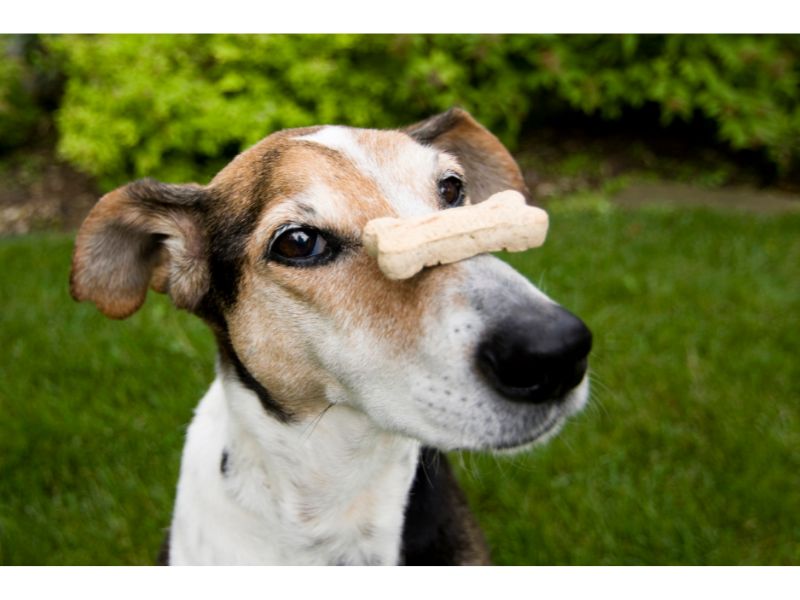To soften the rawhide for dogs, you can soak it in warm water for an hour or use a commercial rawhide softener spray. Rawhide is a popular chew treat for dogs that helps promote dental health and keeps them entertained.
- Why Rawhide Softening Is Important For Your Dog's Dental Health
- Understanding The Different Types Of Rawhide
- Preparation: Gathering The Necessary Supplies
- Step 1: Soaking Rawhide
- Step 2: Flattening And Stretching Rawhide
- Step 3: Air Drying Rawhide
- Step 4: Storing And Monitoring Softened Rawhide
- Bonus Tip: Natural Alternatives To Rawhide
- Frequently Asked Questions On How To Soften Rawhide For Dogs
- Conclusion
However, rawhide can be tough and difficult for some dogs to chew on, especially for puppies or senior dogs with dental issues. To make the rawhide more pliable and easier to chew, there are a few simple methods you can use to soften it.
This article will discuss effective ways to soften rawhide for dogs, ensuring that they can enjoy their chew treat without any discomfort or potential damage to their teeth. So, if you’re ready to learn how to make rawhide more enticing and enjoyable for your furry friend, let’s dive right in.
Why Rawhide Softening Is Important For Your Dog’s Dental Health
The health of your dog’s teeth and gums is crucial in ensuring their overall well-being. As a responsible pet owner, you must understand the significance of rawhide softening for your dog’s dental health. Rawhide is a popular option for dogs to chew on, as it not only helps satisfy their natural chewing instincts but also contributes to maintaining healthy teeth and gums.
Benefits Of Softening Rawhide For Dogs’ Teeth And Gums
When it comes to the dental health of your dog, ensuring their rawhide is properly softened offers numerous benefits. Let’s take a look at some of the key advantages:
Promotes better chewing habits
Softened rawhide encourages your dog to chew more effectively, resulting in improved dental health. When rawhide is softened, it becomes easier for your dog to manipulate with their teeth, enabling better cleaning of their gums and reducing the risk of plaque and tartar build-up. Regular chewing also helps strengthen their jaw muscles and alleviates any potential aggression or boredom-related chewing habits.
Strengthens teeth and gums
Chewing on softened rawhide helps promote healthier teeth and gums. The process of chewing stimulates the production of saliva, which in turn helps wash away harmful bacteria and food particles from your dog’s mouth. This reduces the risk of dental issues such as gum disease, tooth decay, and bad breath. Softened rawhide also provides gentle yet effective friction against your dog’s teeth, assisting in removing plaque and tartar build-up.
Reduces the risk of dental problems
Regularly giving your dog softened rawhide to chew on can significantly reduce the risk of various dental problems. Dental issues can be painful for your furry friend and may even require expensive veterinary treatments. By incorporating softened rawhide into their chewing routine, you can help prevent these issues and ensure your dog’s dental health remains in optimal condition.
How Softened Rawhide Promotes Better Chewing Habits, Ensuring
To optimize the benefits of softened rawhide, it is important to understand how it promotes better chewing habits in your dog. Ensuring a proper chewing routine is essential for maintaining dental health in the long run. By providing softened rawhide, you encourage your dog to chew more actively, which helps remove plaque, tartar, and other debris that can lead to dental problems. The act of chewing also stimulates blood flow to their gums, supporting healthy tissues and reducing the risk of gum disease.
It is essential to note that not all rawhides are made the same, and choosing a high-quality, natural, and easily digestible option is crucial. Always consult with your veterinarian to determine the appropriate type and size of rawhide for your dog, as individual factors such as age, breed, and dental condition may vary.
Incorporating softened rawhide into your dog’s dental care routine can offer tremendous benefits. Regular chewing not only helps maintain their oral hygiene but also provides a stimulating activity that helps alleviate boredom and stress. Remember to supervise your dog while they chew and remove any small or worn-out pieces of rawhide to prevent choking hazards
Understanding The Different Types Of Rawhide
When it comes to selecting the right rawhide for your furry friend, understanding the different types available is crucial. Rawhide is a popular chew treat that not only keeps dogs occupied but also helps promote dental health. However, not all rawhide is created equal, and it’s important to choose the right type for your dog’s individual needs. In this article, we’ll provide a brief overview of rawhide and its variations, discuss how to choose the right type and explore the benefits of specific rawhide types.
Brief Overview Of Rawhide And Its Variations
Rawhide is made from the inner layer of animal hides, usually from cows. It goes through a process of cleaning and drying, resulting in a tough and durable material that dogs love to chew on. Rawhide is available in different forms and shapes, including rolls, bones, chips, and knots.
To help you understand the variations of rawhide better, take a look at the table below:
| Type of Rawhide | Description |
|---|---|
| Standard Rawhide | This is the most common type of rawhide, made from the inner layer of cowhide. It is available in different shapes and sizes and can keep dogs entertained for hours. |
| Premium Rawhide | Considered to be of higher quality than standard rawhide, premium rawhide undergoes a longer processing time, resulting in a thicker and more durable chew. |
| Flavored Rawhide | These rawhide treats are infused with various flavours such as beef, chicken, or bacon to entice dogs and make chewing even more enjoyable. It’s important to choose flavours that are safe for dogs, avoiding any harmful additives or preservatives. |
| Dental Rawhide | Designed specifically to promote dental health, dental rawhide often has abrasive textures or added ingredients that help reduce plaque and tartar buildup on your dog’s teeth. |
Choosing The Right Type Of Rawhide For Your Dog
When selecting rawhide for your dog, it’s important to consider their age, size, chewing habits, and any specific health concerns they may have. Here are some factors to keep in mind:
- Size: Choose a rawhide that is appropriate in size for your dog. Avoid giving them a rawhide that is too small, as it could pose a choking hazard. Alternatively, a rawhide that is too large may be difficult for them to chew.
- Chewing Habits: If your dog is an aggressive chewer, you may want to opt for a thicker and more durable rawhide, such as premium rawhide or dental rawhide.
- Health Concerns: If your furry friend has certain health conditions, consult with your veterinarian before introducing rawhide into their diet. For example, some dogs may have sensitivities or allergies to specific ingredients.
Exploring The Benefits Of Specific Rawhide Types
Each type of rawhide offers unique benefits for your dog. Let’s take a closer look:
- Standard Rawhide: Provides long-lasting entertainment and can help satisfy your dog’s natural instinct to chew. It is a great option for dogs with moderate chewing habits.
- Premium Rawhide: Offers a more durable chew experience, making it ideal for dogs who are aggressive chewers or have a strong jaw.
- Flavoured Rawhide: Adds an extra element of enjoyment to chewing, making it a great choice for dogs who are picky eaters or need extra encouragement to chew.
- Dental Rawhide: Helps promote dental health by reducing plaque and tartar buildup, which can contribute to fresher breath and healthier gums.
By considering your dog’s needs and preferences, you can select the most suitable type of rawhide. Remember to always supervise your dog while they chew and remove any small or broken pieces to prevent choking hazards. With the right rawhide, your dog can enjoy a tasty and beneficial chew that keeps their teeth and gums happy and healthy.
Preparation: Gathering The Necessary Supplies
Before you embark on the process of softening rawhide for your furry friend, it’s crucial to gather all the necessary supplies. This step will ensure that you have everything at your fingertips, allowing for a smooth and hassle-free experience. Additionally, by being prepared with the essential items needed for softening rawhide, you can ensure the best results for your dog’s enjoyment.
Essential Items Needed For Softening Rawhide
To soften rawhide for dogs, you’ll need a few key items in your arsenal. These include:
- High-quality rawhide: Rawhide that is of good quality will not only soften more effectively but also provide a longer-lasting chewing experience. Look for rawhide made from 100% natural ingredients and avoid those that contain additives or preservatives.
- Large container or bowl: A container or bowl that is large enough to comfortably submerge the rawhide is essential. Ensure that it is clean and free from any contaminants to maintain the integrity of the rawhide.
- Warm water: The water you use to soften the rawhide should be warm, but not scalding hot. This temperature helps to break down the tough fibres of the rawhide more effectively.
- Optional additives: While not necessary, you may choose to include additives to enhance the flavour and aroma of the rawhide. This can include low-sodium chicken or beef broth, natural flavourings, or even dog-friendly seasonings. Be sure to select additives that are safe for your dog to consume.
- Patience and time: Softening rawhide is not an instantaneous process. It requires time and patience to allow the rawhide to absorb the water fully. Make sure you have dedicated time available to monitor the softening process and give your dog the best possible experience with the softened rawhide.
Tips For Selecting High-quality Rawhide
Choosing high-quality rawhide ensures that you provide your dog with the safest and most enjoyable chewing experience. Keep the following tips in mind when selecting rawhide for your furry companion:
- Inspect the label: Read the label carefully to ensure that the rawhide is made from non-toxic materials and does not contain any harmful additives like artificial colours or flavours.
- Look for thickness: Thicker rawhide tends to last longer and provides a more substantial chewing experience for your dog.
- Consider your dog’s size: Choose a rawhide that is appropriate for your dog’s size. For small breeds, opt for thinner strips, while larger breeds may benefit from thicker rawhide.
- Opt for natural options: Go for rawhide made from natural ingredients, such as those sourced from grass-fed cattle, to minimize the risk of digestive issues or allergic reactions.
- Check for flexible texture: A flexible texture indicates that the rawhide has undergone proper processing and will be easier to soften for your dog’s enjoyment.
Step 1: Soaking Rawhide
Soaking rawhide is an essential step in the process of softening it for your dog. By properly soaking the rawhide, you can make it more palatable and easier for your furry friend to chew on. In this article, we will discuss the proper soaking techniques, duration, and water temperature recommendations to ensure that the rawhide is softened safely.
Proper Soaking Techniques To Soften Rawhide Safely
When it comes to soaking rawhide, there are a few key techniques to keep in mind to ensure the best results:
- Choose the right container: Select a container that is large enough to accommodate the size of the rawhide and deep enough to fully submerge it. This will allow the rawhide to absorb water evenly during the soaking process.
- Use room temperature water: It is important to use water that is neither too hot nor too cold. Room temperature water is ideal as it helps expedite the softening process without altering the texture of the rawhide.
- Submerge the rawhide completely: Place the rawhide in the container, making sure it is fully submerged in water. This will allow the water to penetrate the rawhide evenly, ensuring it softens uniformly.
- Soak for the recommended duration: The duration of soaking depends on the size and thickness of the rawhide. As a general rule of thumb, smaller and thinner rawhide pieces may need around 30 minutes to an hour, while larger and thicker pieces may require several hours or even overnight soaking.
Duration And Water Temperature Recommendations
The duration of soaking and the water temperature can greatly affect the softening process. Here are some general recommendations:
| Rawhide Size/Thickness | Duration | Water Temperature |
|---|---|---|
| Small/Thin | 30 minutes to 1 hour | Room temperature |
| Medium/Moderate | 2-3 hours | Room temperature |
| Large/Thick | 4+ hours or overnight | Room temperature |
Note: These recommended durations are general guidelines and may vary depending on the specific rawhide product you are using. Always refer to the manufacturer’s instructions if available.
By following these proper soaking techniques and adhering to the recommended duration and water temperature guidelines, you can safely soften the rawhide for your dog. In the next steps, we will explore additional methods to further soften rawhide, ensuring your furry friend enjoys a satisfying chewing experience.
Step 2: Flattening And Stretching Rawhide
Once you have soaked the rawhide in water, the next important step is to flatten and stretch it. This step helps to create a uniform thickness throughout the rawhide, which is crucial for ensuring its safety and durability for your dogs. In this section, we will explore different techniques for flattening and stretching rawhide evenly. Let’s dive in!
Techniques For Flattening And Stretching Rawhide Evenly
Flattening and stretching rawhide may seem like a challenging task, but with the right techniques, you can achieve the desired results. Here are some effective methods to ensure your rawhide is flat and evenly stretched:
1. Using A Flat Surface And Heavy Objects
One of the simplest and most common techniques is to use a flat surface and heavy objects to flatten and stretch the rawhide. Here’s how you can do it:
- Place the soaked rawhide on a flat surface, such as a table or countertop.
- Carefully flatten the rawhide by pressing it down with your hands.
- Place heavy objects, like books or weights, on top of the rawhide.
- Leave the rawhide under the pressure of heavy objects for a few hours or overnight to allow it to stretch and flatten.
This technique helps to evenly distribute the pressure and create a uniform thickness.
2. Using A Rolling Pin
Another effective method for flattening and stretching rawhide is by using a rolling pin. Follow these steps:
- Place the soaked rawhide on a clean, flat surface.
- Hold the edges of the rawhide firmly and use a rolling pin to apply pressure evenly across the surface.
- Roll the pin in both directions (horizontally and vertically) to ensure an even stretch.
This technique allows you to control the pressure and thickness of the rawhide as you roll it out.
Importance Of Creating A Uniform Thickness
Creating a uniform thickness is essential when working with rawhide. Here’s why:
- Chewing Safety: Dogs need rawhide that is of consistent thickness to help prevent choking hazards. A properly flattened and stretched rawhide reduces the risk of a piece breaking off and becoming lodged in your dog’s throat.
- Durability: A uniform thickness ensures the rawhide is strong and durable. When chewed on, it maintains its structural integrity, making it last longer and providing more entertainment for your furry friend.
- Even Chewing Experience: Rawhide with a uniform thickness offers an even chewing experience for your dog. It allows them to chew on the entire piece without encountering unexpected thickness variations.
By following the techniques mentioned above and ensuring a consistent thickness, you can make the rawhide safe, enjoyable, and long-lasting for your beloved pets.
Step 3: Air Drying Rawhide
Best Practices For Air Drying To Achieve Desired Texture
Once you have soaked and cleaned the rawhide, the next step is air drying. This crucial step ensures that the rawhide becomes chewable and safe for your furry friend. Proper air drying will give the rawhide the desired texture, making it more enjoyable for your dog to chew on.
To achieve the best results, here are some best practices to follow when air-drying rawhide:
- Avoid direct sunlight: While sunlight can help speed up the drying process, exposing the rawhide to direct sunlight for too long can cause it to become brittle and lose its desired texture. Therefore, it’s best to find a shady area to air-dry the rawhide.
- Provide proper ventilation: Good airflow is essential for the drying process. Ensure that the rawhide is placed in an area with adequate ventilation, as it helps to remove moisture and aids in the drying process.
- Elevate the rawhide: Placing the rawhide on a raised surface, such as a wire rack, allows air to circulate around the entire rawhide, ensuring it dries evenly. This helps prevent any damp spots or areas from developing, which could lead to mould or unpleasant odours.
- Periodically flip and rotate: While the rawhide is air drying, periodically flip and rotate it to ensure even drying. This step helps to prevent any areas from becoming too moist or drying unevenly.
Importance Of Allowing Rawhide To Fully Dry Before Giving It To Your Dog
Fully drying the rawhide before giving it to your dog is of utmost importance for their safety and enjoyment. When the rawhide is not completely dried, it can still retain moisture, leading to potential issues such as mould or bacterial growth.
By allowing the rawhide to fully dry, you ensure that it becomes chewable and safe for your dog’s oral health. Additionally, the drying process helps to remove any remaining impurities, dirt, or bacteria from the rawhide, making it a safe and clean chew toy.
Remember, a fully dried rawhide ensures that your dog can enjoy a long-lasting, satisfying chewing experience without any concerns. So be patient and let the air-drying process work its magic before handing over the finished rawhide to your furry friend.
Now that the rawhide has been air-dried to perfection, it’s time for the final step – giving it to your dog!
Step 4: Storing And Monitoring Softened Rawhide
Once you have successfully softened your rawhide for your furry friend, it’s crucial to store it properly to maintain freshness and prevent mould. Additionally, regular monitoring is essential to ensure that the softened rawhide remains in good condition and doesn’t pose any risks to your dog’s health. Here are some tips on proper storage methods and monitoring for signs of spoilage or degradation:
Proper Storage Methods To Maintain Freshness And Prevent Mold
When it comes to storing softened rawhide, following the right methods is key to preserving its texture and taste. Here are some guidelines to keep in mind:
- Store the softened rawhide in a cool, dry place: Exposing it to excessive heat or moisture can lead to spoilage and mold growth.
- Keep it away from direct sunlight: Sunlight can cause the rawhide to dry out and become brittle.
- Consider using an airtight container: This can help maintain the moisture levels of the rawhide and prevent it from becoming too dry or too moist.
- Separate the rawhide from other treats or foods: This prevents cross-contamination and ensures that the rawhide remains fresh and safe to consume.
- Label the storage container with the date: This allows you to keep track of how long the rawhide has been stored and helps you prioritize its usage based on freshness.
Regular Checking For Any Signs Of Spoilage Or Degradation
Even with proper storage, there is still a chance that the softened rawhide can spoil or degrade over time. It’s essential to monitor it regularly to ensure its quality and safety. Here are some signs to watch out for:
- Visible mould growth: If you notice any white or green fuzzy patches on the rawhide, it indicates mould growth. Dispose of it immediately as ingestion of mold can be harmful to your dog’s health.
- Unpleasant odour: A foul smell emanating from the softened rawhide could indicate spoilage. Trust your sense of smell and discard it if it doesn’t smell right.
- Change in texture or appearance: If the softened rawhide becomes slimy, discoloured, or overly soft, it may have started to deteriorate. These changes are a clear sign that it’s time to replace it.
- Bacterial contamination: In rare cases, bacteria can grow on the rawhide and cause digestive issues for your dog. If your furry friend experiences any gastrointestinal discomfort after consuming the softened rawhide, consult a veterinarian.
By following these proper storage methods and regularly monitoring the softened rawhide, you can ensure that your pup receives a safe and enjoyable chewing experience. Take good care of your dog’s treats, and they’ll enjoy the benefits for a long time!
Bonus Tip: Natural Alternatives To Rawhide
Introduction
Rawhide has long been a popular choice for dog owners seeking a durable and entertaining chew toy for their furry friends. However, there are concerns about the safety and digestibility of rawhide, making many pet owners explore natural alternatives to this traditional option. In this article, we will discuss some healthier choices that provide similar benefits to rawhide, ensuring the safety and enjoyment of your canine companion. So, let’s dive into our bonus tip: Natural Alternatives to Rawhide.
Exploring Alternative Chew Options For Dogs With Specific Needs
Different dogs have different dental needs and preferences when it comes to chew toys. Some may have sensitivities or allergies that require special attention. Here, we will explore a few natural alternatives to rawhide that cater to these specific needs:
Introduction To Healthier Choices That Provide Similar Benefits
When choosing alternatives to rawhide, it’s important to consider options that offer similar benefits to keep your dog healthy and happy. Here are some natural choices that can replace rawhide without compromising on quality:
| Alternatives | Description |
|---|---|
| Antlers | Naturally shed antlers are a fantastic alternative for dogs who love to chew. They are long-lasting, odour-free, and provide essential minerals for your dog’s overall health. |
| Vegetable-based Chews | There are a variety of all-natural chew toys made from vegetables, like sweet potato or carrots. These options are not only tasty for your pet but also rich in vitamins and minerals. |
| Raw Bones | Raw bones, such as beef or lamb bones, can provide hours of entertainment for your dog. They aid in teeth cleaning and help satisfy your dog’s natural instinct to chew. |
Remember, when introducing any new chew toy to your dog, it’s essential to supervise their chewing habits and ensure the toy is appropriate for their size and chewing style.
By exploring these natural alternatives to rawhide, you can provide your dog with safe and enjoyable chew options that promote dental health and overall well-being. So why wait? Start incorporating these healthier choices into your furry friend’s playtime routine today!
Frequently Asked Questions On How To Soften Rawhide For Dogs
How Do You Soften Rawhide For Dogs?
To soften the rawhide for your dog, soak it in warm water for 15-30 minutes until it becomes pliable. You can also try using a chew-softening spray or rubbing coconut oil onto the rawhide. Avoid microwaving or boiling the rawhide, as it may make it unsafe for your dog to chew on.
Conclusion
Softening rawhide for dogs is an essential step to ensure their safety and enjoyment. By following the simple techniques discussed in this blog post, you can easily make rawhide treats more palatable and easier to chew for your furry friend.
Remember to consider your dog’s size, preferences, and dietary restrictions when choosing the method that works best for them. With these tips, you can provide your dog with a satisfying chewing experience while promoting good oral health.




